




British Museum Top 20 Buddhism 04-1 Dunhuang Two standing Avalokiteshvara [4 of 26]
4-1. Two Standing Avalokiteshvara - Cave 17 Dunhuang China, mid 9C AD, 147 x 105 cm. The British Museum has many artifacts that are not on display, like this one of almost 400 priceless Buddhist paintings on silk from the Dunhuang cave complex in China from the Stein collection. The painting shows two almost identical figures of Avalokiteshvara, one of the most popular of the bodhisattvas, identifiable by the small figure of the Buddha Amitabha in his headdress. One of the only differences between the two figures are the attributes that they hold: that on the left holds a flower, that on the right a vase and a willow branch. All three were popular attributes of Avalokiteshvara. The inscription in the centre of the painting translates in part: '…the disciple of pure faith, Yiwen, on his own behalf, having fallen [into the hands of the Tibetans], hopes that he return to his birthplace.' Therefore this example was commissioned to ensure a peaceful life during the period of war with the Tibetans, who finally had to give up Dunhuang in 948 AD. For more information on Dunhuang, check out The International Dunhuang Project. Photo: http://www.britishmuseum.org.
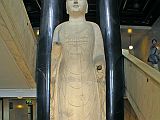
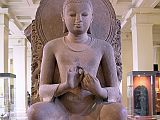
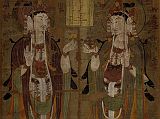
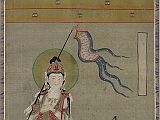
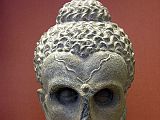
![British Museum Top 20 Buddhism 04-1 Dunhuang Two standing Avalokiteshvara 4-1. Two Standing Avalokiteshvara - Cave 17 Dunhuang China, mid 9C AD, 147 x 105 cm. The British Museum has many artifacts that are not on display, like this one of almost 400 priceless Buddhist paintings on silk from the Dunhuang cave complex in China from the Stein collection. The painting shows two almost identical figures of Avalokiteshvara, one of the most popular of the bodhisattvas, identifiable by the small figure of the Buddha Amitabha in his headdress. One of the only differences between the two figures are the attributes that they hold: that on the left holds a flower, that on the right a vase and a willow branch. All three were popular attributes of Avalokiteshvara. The inscription in the centre of the painting translates in part: '…the disciple of pure faith, Yiwen, on his own behalf, having fallen [into the hands of the Tibetans], hopes that he return to his birthplace.' Therefore this example was commissioned to ensure a peaceful life during the period of war with the Tibetans, who finally had to give up Dunhuang in 948 AD. For more information on Dunhuang, check out <a class='a' href='http://idp.bl.uk/idp.a4d'>The International Dunhuang Project</a>. Photo: http://www.britishmuseum.org. British Museum Top 20 Buddhism 04-1 Dunhuang Two standing Avalokiteshvara 4-1. Two Standing Avalokiteshvara - Cave 17 Dunhuang China, mid 9C AD, 147 x 105 cm. The British Museum has many artifacts that are not on display, like this one of almost 400 priceless Buddhist paintings on silk from the Dunhuang cave complex in China from the Stein collection. The painting shows two almost identical figures of Avalokiteshvara, one of the most popular of the bodhisattvas, identifiable by the small figure of the Buddha Amitabha in his headdress. One of the only differences between the two figures are the attributes that they hold: that on the left holds a flower, that on the right a vase and a willow branch. All three were popular attributes of Avalokiteshvara. The inscription in the centre of the painting translates in part: '…the disciple of pure faith, Yiwen, on his own behalf, having fallen [into the hands of the Tibetans], hopes that he return to his birthplace.' Therefore this example was commissioned to ensure a peaceful life during the period of war with the Tibetans, who finally had to give up Dunhuang in 948 AD. For more information on Dunhuang, check out <a class='a' href='http://idp.bl.uk/idp.a4d'>The International Dunhuang Project</a>. Photo: http://www.britishmuseum.org.](British Museum Top 20 Buddhism 04-1 Dunhuang Two standing Avalokiteshvara.jpg)